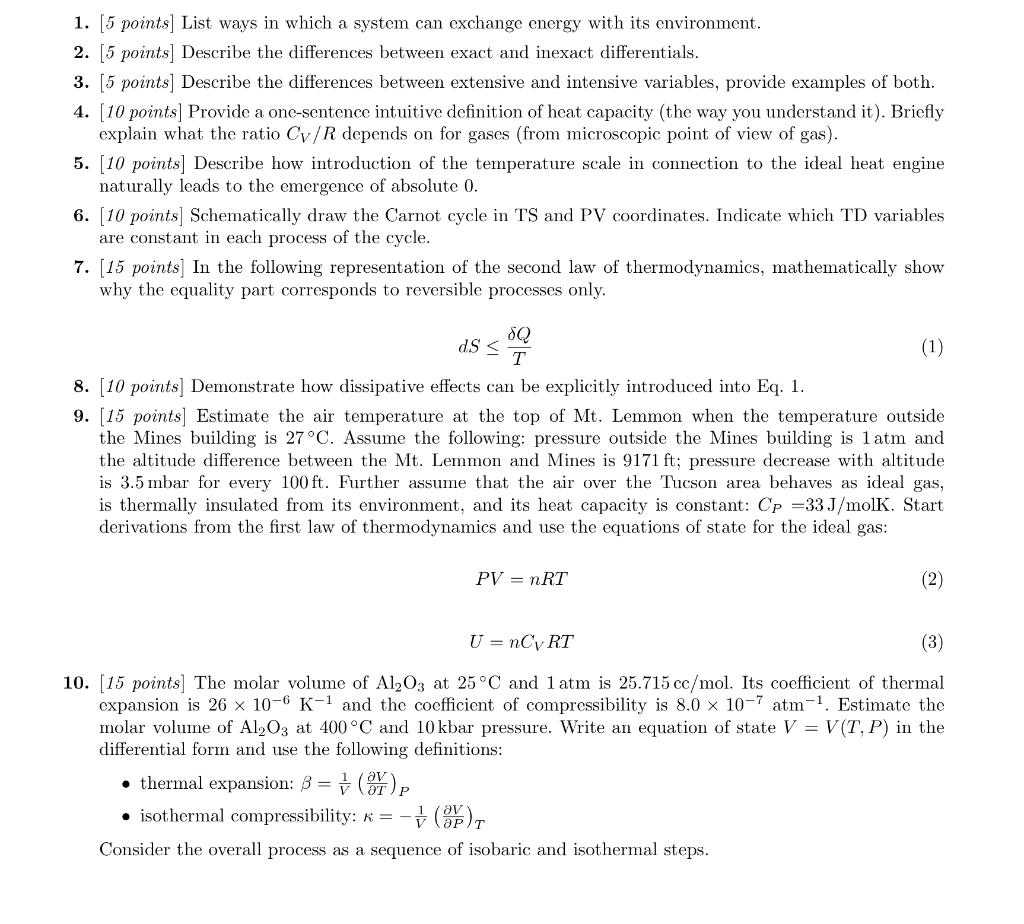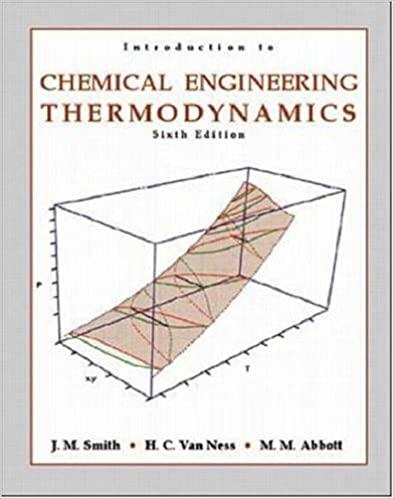Answered step by step
Verified Expert Solution
Question
1 Approved Answer
I really need help with these please!!! 1. [5 points ] List ways in which a system can exchange energy with its environment. 2. [5

I really need help with these please!!!
1. [5 points ] List ways in which a system can exchange energy with its environment. 2. [5 points] Describe the differences between exact and inexact differentials. 3. 5 points ] Describe the differences between extensive and intensive variables, provide examples of both. 4. [10 points] Provide a one-sentence intuitive definition of heat capacity (the way you understand it). Briefly explain what the ratio CV/R depends on for gases (from microscopic point of view of gas). 5. [10 points] Describe how introduction of the temperature scale in connection to the ideal heat engine naturally leads to the emergence of absolute 0 . 6. [10 points] Schematically draw the Carnot cycle in TS and PV coordinates. Indicate which TD variables are constant in each process of the cycle. 7. 15 points] In the following representation of the second law of thermodynamics, mathematically show why the equality part corresponds to reversible processes only. dSTQ 8. [10 points ] Demonstrate how dissipative effects can be explicitly introduced into Eq. 1 . 9. 15 points ] Estimate the air temperature at the top of Mt. Lemmon when the temperature outside the Mines building is 27C. Assume the following: pressure outside the Mines building is 1atm and the altitude difference between the Mt. Lemmon and Mines is 9171ft; pressure decrease with altitude is 3.5mbar for every 100ft. Further assume that the air over the Tucson area behaves as ideal gas, is thermally insulated from its environment, and its heat capacity is constant: CP=33J/molK. Start derivations from the first law of thermodynamics and use the equations of state for the ideal gas: PV=nRTU=nCVRT 10. [15 points] The molar volume of Al2O3 at 25C and 1atm is 25.715cc/mol. Its coefficient of thermal expansion is 26106K1 and the coefficient of compressibility is 8.0107atm1. Estimate the molar volume of Al2O3 at 400C and 10 kbar pressure. Write an equation of state V=V(T,P) in the differential form and use the following definitions: - thermal expansion: =V1(TV)P - isothermal compressibility: =V1(PV)T Consider the overall process as a sequence of isobaric and isothermal steps. 1. [5 points ] List ways in which a system can exchange energy with its environment. 2. [5 points] Describe the differences between exact and inexact differentials. 3. 5 points ] Describe the differences between extensive and intensive variables, provide examples of both. 4. [10 points] Provide a one-sentence intuitive definition of heat capacity (the way you understand it). Briefly explain what the ratio CV/R depends on for gases (from microscopic point of view of gas). 5. [10 points] Describe how introduction of the temperature scale in connection to the ideal heat engine naturally leads to the emergence of absolute 0 . 6. [10 points] Schematically draw the Carnot cycle in TS and PV coordinates. Indicate which TD variables are constant in each process of the cycle. 7. 15 points] In the following representation of the second law of thermodynamics, mathematically show why the equality part corresponds to reversible processes only. dSTQ 8. [10 points ] Demonstrate how dissipative effects can be explicitly introduced into Eq. 1 . 9. 15 points ] Estimate the air temperature at the top of Mt. Lemmon when the temperature outside the Mines building is 27C. Assume the following: pressure outside the Mines building is 1atm and the altitude difference between the Mt. Lemmon and Mines is 9171ft; pressure decrease with altitude is 3.5mbar for every 100ft. Further assume that the air over the Tucson area behaves as ideal gas, is thermally insulated from its environment, and its heat capacity is constant: CP=33J/molK. Start derivations from the first law of thermodynamics and use the equations of state for the ideal gas: PV=nRTU=nCVRT 10. [15 points] The molar volume of Al2O3 at 25C and 1atm is 25.715cc/mol. Its coefficient of thermal expansion is 26106K1 and the coefficient of compressibility is 8.0107atm1. Estimate the molar volume of Al2O3 at 400C and 10 kbar pressure. Write an equation of state V=V(T,P) in the differential form and use the following definitions: - thermal expansion: =V1(TV)P - isothermal compressibility: =V1(PV)T Consider the overall process as a sequence of isobaric and isothermal stepsStep by Step Solution
There are 3 Steps involved in it
Step: 1

Get Instant Access to Expert-Tailored Solutions
See step-by-step solutions with expert insights and AI powered tools for academic success
Step: 2

Step: 3

Ace Your Homework with AI
Get the answers you need in no time with our AI-driven, step-by-step assistance
Get Started


